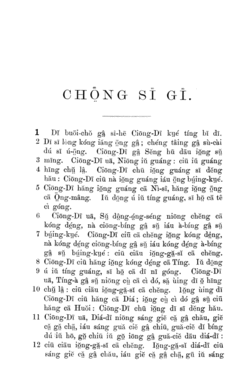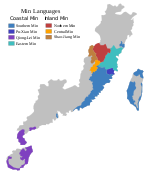(Redirected from Kienow )
Dialect of Northern Min Chinese
‹ The template Infobox language considered for merging . ›
Bible in Jian'ou Romanised (Genesis ), published by the British and Foreign Bible Society . The Jian'ou dialect (Northern Min : Gṳ̿ing-é-dī / 建甌事; Chinese : simplified Chinese : 建瓯话; traditional Chinese : 建甌話; pinyin : Jiàn'ōuhuà ), also known as Kienow dialect , is a local dialect of Northern Min Chinese spoken in Jian'ou in northern Fujian province. It is regarded as the standard common language in Jian'ou.
Phonetics and phonology
According to The Eight Tones of Kien-chou rime dictionary published in 1795, the Jian'ou dialect had 15 initials, 34 rimes and 7 tones in the 18th century, however there are only 6 tones in the modern dialect as the "light level" (陽平) tone has disappeared.
Initials
Rimes
Tones
Jian'ou has four tones, which are reduced to two in checked syllables.
Tone chart of the Jian'ou dialect
Tone number
Tone name Tone contour
1
level (平聲)
˥˦ (54) or ˥ (5)
2
rising (上聲)
˨˩ (21) or ˩ (1)
3
dark departing (陰去)
˨ (2)
4
light departing (陽去)
˦ (4)
5
dark entering (陰入)
˨˦ (24)
6
light entering (陽入)
˦˨ (42)
The entering tones in the Jian'ou dialect do not have any entering tone coda (入聲韻尾) such as /-ʔ/, /-p̚/, /-t̚/ and /-k̚/ which makes it distinct from many other Chinese varieties.
Notes
References
Mei, Tsu-lin (1970), "Tones and prosody in Middle Chinese and the origin of the rising tone", Harvard Journal of Asiatic Studies , 30 : 86–110, doi :10.2307/2718766 , JSTOR 2718766 Pulleyblank, Edwin G. (1984), Middle Chinese: A study in Historical Phonology , Vancouver: University of British Columbia Press, p. 3, ISBN 978-0-7748-0192-8 Hammarström, Harald ; Forkel, Robert; Haspelmath, Martin ; Bank, Sebastian (2023-07-10). "Glottolog 4.8 - Min" . Glottolog Leipzig : Max Planck Institute for Evolutionary Anthropology . doi :10.5281/zenodo.7398962 . Archived from the original on 2023-10-13. Retrieved 2023-10-13.Kienning Colloquial Romanized has merged into /ɔŋ/ in the modern dialect.
Kienning Colloquial Romanized as it diverged from /iŋ/ after the romanization system was established.
^
^
Sources
Beijing daxue Zhongguo yuyan wenxue xi yuyanxue jiaoyanshi 北京大學中國語言文學系語言學教研室 (1989). Hànyǔ fāngyīn zìhuì 漢語方音字匯 (in Chinese). Beijing: Wenzi gaige chubanshe. Yuan, Jiahua 袁家驊 (1989). Hànyǔ fāngyán gàiyào 漢語方言概要 [An Introduction to Chinese Dialects ] (in Chinese). Beijing: Wenzi gaige chubanshe. Jianou Xian difangzhi bianzuan weiyuanhui 建瓯县地方志编纂委员会 (1994). Jiànōu xiànzhì 建瓯县志 Chorography of Jian'ou County ]. Vol. 36. Beijing: Zhonghua shuju . ISBN 7-101-01283-3 the original on 2018-04-07. Retrieved 2018-04-06. Lien, Chinfa (1990). "Competing Final Systems in the Jian'ou Dialect" (PDF). Tsing Hua Journal of Chinese Studies . 20 (1): 1–53. Norman, Jerry (2002) . Chinese . Cambridge: Cambridge University Press. ISBN 0-521-29653-6 External links
Category :
Text is available under the Creative Commons Attribution-ShareAlike License. Additional terms may apply.
**DISCLAIMER** We are not affiliated with Wikipedia, and Cloudflare.
The information presented on this site is for general informational purposes only and does not constitute medical advice.
You should always have a personal consultation with a healthcare professional before making changes to your diet, medication, or exercise routine.
AI helps with the correspondence in our chat.
We participate in an affiliate program. If you buy something through a link, we may earn a commission 💕
↑


